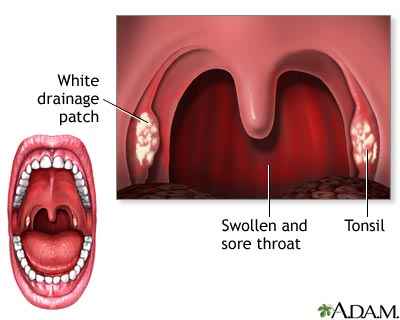Nursing Paper Example on Strep Throat
Nursing Paper Example on Strep Throat
Strep throat, or streptococcal pharyngitis, is a bacterial infection caused by Streptococcus pyogenes, also known as group A Streptococcus. It primarily affects the throat and tonsils, leading to a sore throat, fever, and other symptoms. While strep throat can affect people of all ages, it is most common in children and adolescents. Left untreated, strep throat may lead to complications, some of which can be severe, such as rheumatic fever and kidney inflammation. This overview addresses the causes, pathophysiology, signs and symptoms, diagnosis, treatment options, and potential complications of strep throat.

Causes and Pathophysiology
Primary Cause
Strep throat is caused by the bacterium Streptococcus pyogenes, a gram-positive pathogen that spreads through respiratory droplets. The infection is highly contagious and spreads via close contact, sharing of personal items, or exposure to contaminated surfaces. Once the bacteria enter the body, they can colonize the mucosal tissues in the throat, leading to inflammation and infection (Cohen-Poradosu & Kasper, 2022).
Pathophysiology
When Streptococcus pyogenes enters the throat, it produces various virulence factors that enable it to adhere to and invade epithelial cells. These include M proteins, hyaluronic acid capsules, and exotoxins. The M proteins allow the bacteria to evade the host’s immune response, while the exotoxins cause tissue damage and inflammation, resulting in the characteristic symptoms of strep throat (Shulman et al., 2012).
(Nursing Paper Example on Strep Throat)
Signs and Symptoms
Primary Symptoms
The common symptoms of strep throat include:
- Severe sore throat
- Pain while swallowing
- Red and swollen tonsils, sometimes with white patches or streaks of pus
- Fever, usually over 101°F (38.3°C)
- Swollen lymph nodes, particularly in the neck
Additional Symptoms
Some individuals may also experience symptoms such as headache, abdominal pain, nausea, and vomiting, especially in children. Unlike viral infections, strep throat typically lacks cough, hoarseness, or runny nose, helping differentiate it from other throat infections (Mayo Clinic, 2023).
Diagnosis
Physical Examination and History
Healthcare providers initially assess symptoms and examine the throat, noting redness, swelling, and any white patches. Swollen lymph nodes are another indicator that may prompt further testing.
Rapid Antigen Detection Test (RADT)
The RADT is a quick test used to identify the presence of group A Streptococcus antigens. This test provides results within minutes and has high specificity, but a lower sensitivity. A negative result may require confirmation with a throat culture (Shulman et al., 2012).
Throat Culture
A throat culture remains the gold standard for diagnosing strep throat due to its high accuracy. Although it takes 24-48 hours to get results, it is crucial for confirming strep throat in cases where RADT is negative. Throat cultures are particularly recommended for children and adolescents to prevent complications (Cohen-Poradosu & Kasper, 2022).
Treatment and Management
Antibiotic Therapy
The standard treatment for strep throat is antibiotics, with penicillin and amoxicillin being the most common choices due to their effectiveness and low risk of resistance. For patients allergic to penicillin, alternatives include cephalexin, clindamycin, and azithromycin. Antibiotic therapy generally shortens the duration of symptoms, reduces transmission risk, and prevents complications like rheumatic fever (Shulman et al., 2012).
Symptomatic Relief
In addition to antibiotics, symptomatic treatment includes:
- Over-the-counter pain relievers like ibuprofen or acetaminophen to reduce fever and relieve pain.
- Warm saltwater gargles to soothe throat discomfort.
- Increased fluid intake to stay hydrated and reduce throat irritation.
Rest and Isolation
Rest is advised to help the immune system recover. Patients should remain home from school or work for at least 24 hours after starting antibiotics to prevent spreading the infection (Mayo Clinic, 2023).
(Nursing Paper Example on Strep Throat)
Complications
Acute Complications
Without prompt treatment, strep throat can lead to several acute complications, including:
- Peritonsillar abscess: A collection of pus near the tonsils that can cause severe pain and may require drainage.
- Otitis media: Middle ear infection that can develop from the spread of bacteria.
Post-Streptococcal Complications
If strep throat is untreated or inadequately treated, certain immune-mediated complications can occur, including:
- Rheumatic fever: An inflammatory disease that can affect the heart, joints, skin, and brain. Rheumatic fever is associated with long-term cardiac complications, including rheumatic heart disease.
- Post-streptococcal glomerulonephritis: Inflammation of the kidney, leading to hematuria, edema, and hypertension.
These complications underscore the importance of early diagnosis and treatment of strep throat (Cohen-Poradosu & Kasper, 2022).
Prevention
Hygiene Practices
Preventive measures include regular hand washing, covering the mouth when coughing or sneezing, and avoiding sharing personal items. In communal settings like schools, proper hygiene and isolation of infected individuals are vital to minimize the spread.
Awareness in Close Contacts
Household members or close contacts of those infected with strep throat should remain vigilant for symptoms. In some cases, antibiotic prophylaxis may be considered for high-risk individuals to prevent transmission.
Conclusion
Strep throat is a common yet potentially serious bacterial infection that requires prompt medical attention. Caused by Streptococcus pyogenes, it primarily affects the throat, leading to symptoms like sore throat, fever, and swollen lymph nodes. Diagnosis involves clinical examination, RADT, and throat culture. Antibiotic therapy is essential for treatment and prevention of complications such as rheumatic fever and kidney inflammation. Good hygiene practices and isolation during the infectious period are critical to preventing the spread of strep throat in communal settings. Early intervention with antibiotics and supportive care is essential to reduce symptom duration and avoid severe outcomes.
References
Cohen-Poradosu, R., & Kasper, D. L. (2022). Streptococcal infections. In Kasper, D. L., et al. (Eds.), Harrison’s Principles of Internal Medicine, 21st Edition. McGraw Hill. https://accessmedicine.mhmedical.com/content.aspx?bookid=2129§ionid=192014500
Shulman, S. T., Bisno, A. L., Clegg, H. W., Gerber, M. A., Kaplan, E. L., Lee, G., … & Van Beneden, C. (2012). Clinical Practice Guideline for the Diagnosis and Management of Group A Streptococcal Pharyngitis: 2012 Update by the Infectious Diseases Society of America. Clinical Infectious Diseases, 55(10), e86-e102. https://academic.oup.com/cid/article/55/10/e86/321183


